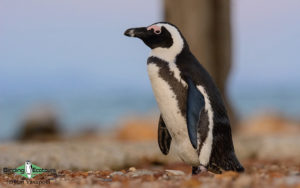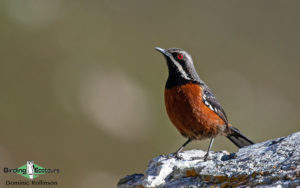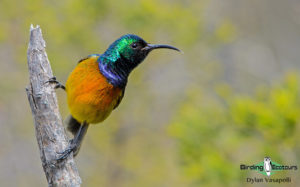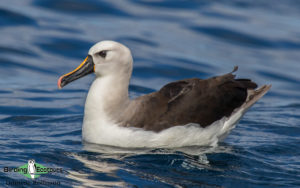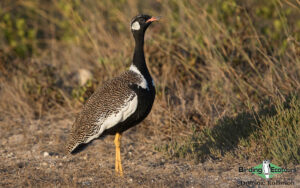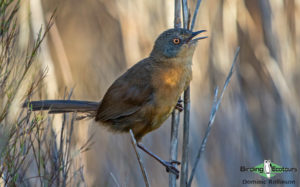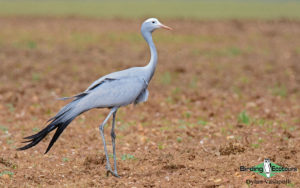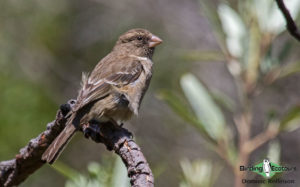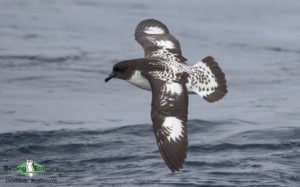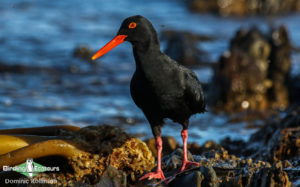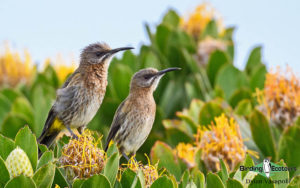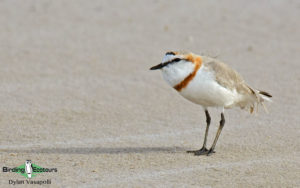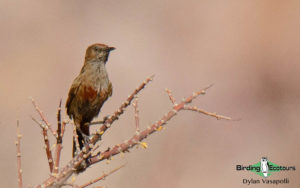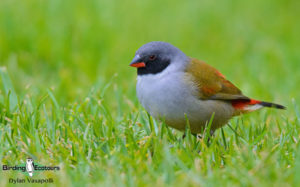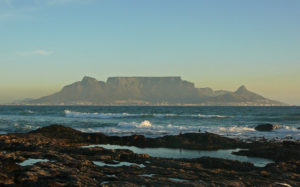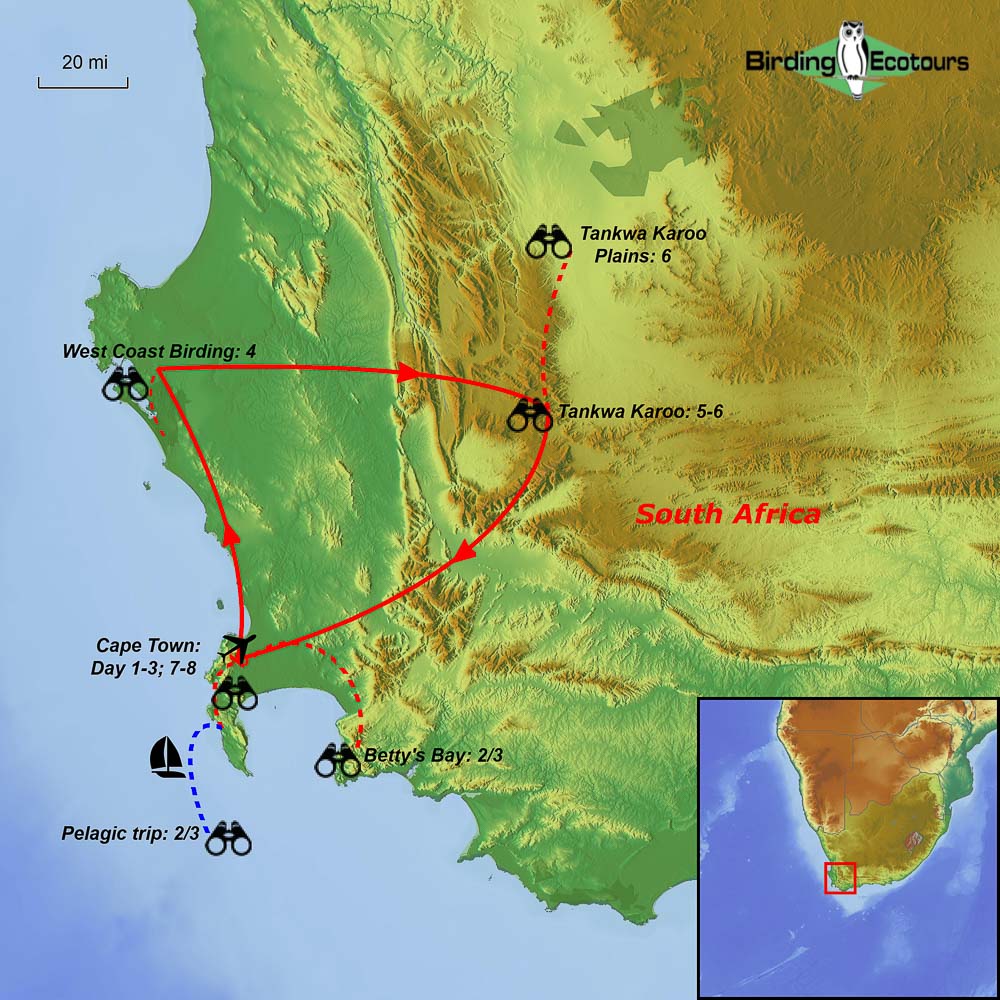Birding Tour South Africa: Best of Cape Town and Beyond — Endemics, seabirds and more
Best of Cape Town and Beyond — Endemics, seabirds and more
October 2026 / 2027
South Africa must surely rank as one of the best value destinations on the entire African continent. The combination of superb accommodation, excellent infrastructure, great food, wonderful South African hospitality, impressive and varied scenery, and the presence of Africa’s big and small mammals makes it one of the most popular countries in the world to bird in. The tour begins in one of the world’s most beautiful cities, Cape Town, where we will search for a host of avian endemics found nowhere else but in the fynbos of the Cape Floral Kingdom (the richest place on earth for plants). While in Cape Town we will also do a pelagic trip, enjoying the great numbers and diversity of seabirds which visit the southern tip of Africa. After a few days birding around Cape Town we then head northward up the west coast and finally head inland through rugged mountain ranges into the Tankwa Karoo, another of Africa’s great endemic hotspots.
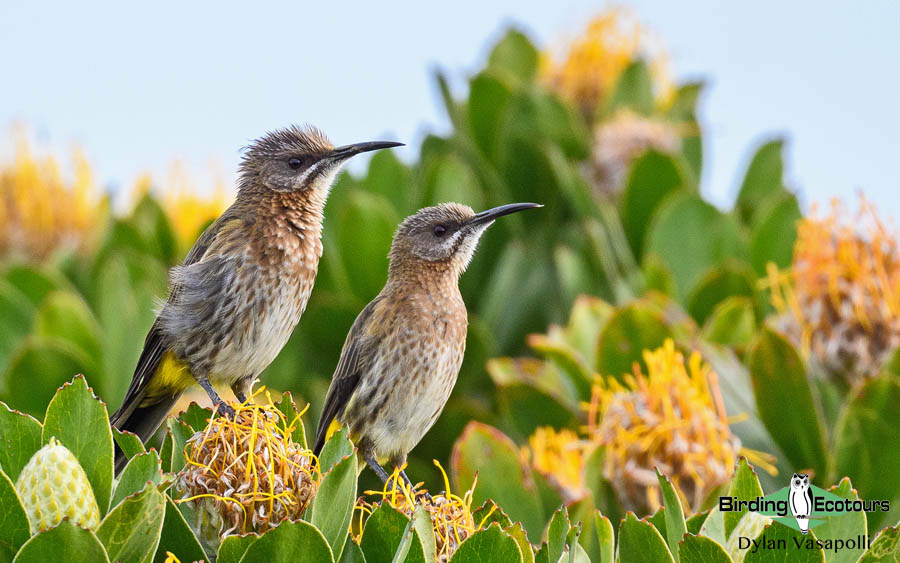
We begin this tour with a private Cape pelagic trip, where we invariably find four albatross species and always hope for an additional rarer one like Wandering Albatross. Then we hope to encounter some very enigmatic birds: Watch a weird little warbler, a desert bird that skulks, disappear into a rock crevice, namely Cinnamon-breasted Warbler, one of the Cape’s strangest endemics and one of the toughest of the many Karoo endemics to see well. Cape Rockjumper has a beautiful call, striking colors, a boisterous personality and a terribly limited distribution around Cape Town. A terrestrial woodpecker, Ground Woodpecker, and African Penguin are also found on the spectacular Cape Peninsula. What more can you possibly ask for of a Cape birding tour?
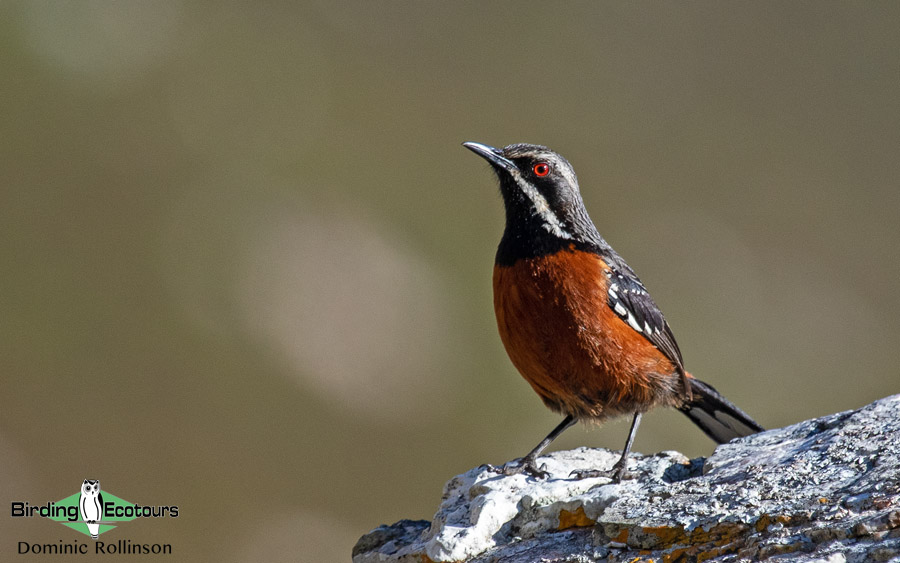
But this trip is not only full of localized avian endemics but also of spectacularly famous scenery, such as the Cape of Good Hope, Cape Point, and Table Mountain. All in all, our eight-day Cape tour is full of localized endemics, spectacular scenery, and so much more. This is where Birding Ecotours started as a company in 2002, and nowhere else do we have as much experience as in the Cape.
The Western Cape is the most important endemic bird area on the entire African continent. It is a truly essential area for any serious birder because of its sheer number of endemics. Pelagic trips off Cape Town also rank as among the finest in the world (with at least four albatross species, Cape Petrel (seasonal), and many more on the rich trawling grounds near where two oceans meet). The Cape is also a spectacularly scenic area, with the rugged Cape Fold Mountains that come right down to the sea, white sand beaches, sea cliffs on the Cape Peninsula, and beautiful vineyards. Close inshore Southern Right Whales (seasonal) plus a lot of other mammals, spectacular carpets of flowers (seasonal), and the most plant-diverse biome on earth (even richer than the Amazon!) are major attractions that are easily seen incidentally, while not jeopardizing our chances of finding all the birds. We recommend at least a week in the Western Cape. The aim of our standard (set departure) eight-day tour (but we can custom-make a trip of any length) is to find a majority of the endemics of this province, with many other species as an unavoidable byproduct (plus, as always, an amazing overall experience), and of course a lot of pelagic and other seabirds. To find the endemics we budget adequate time in each strategic ecosystem – the fynbos, Langebaan Lagoon, and the Karoo.
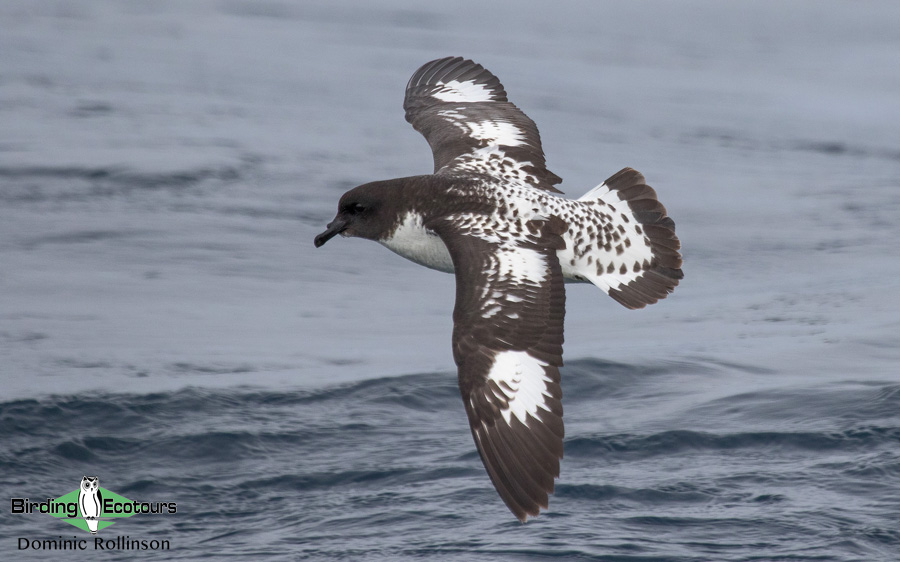
The October departures can be combined with our preceding Kruger National Park and Escarpment Birding Safari and then with our following Subtropical South Africa Birding Tour: Comprehensive Eastern South Africa for a 38-day South African adventure, and, following that, with our Namibia, Okavango and Victoria Falls 18-day Birding Adventure for a stunning 46-day Southern African mega tour.
Itinerary (8 days/7 nights)
Day 1. Arrival in Cape Town
This is the day you need to arrive in Cape Town – any time during the day at your leisure. You will be met at Cape Town International Airport and transferred to our comfortable guesthouse in the leafy Cape Town suburbs. We should hopefully have some time to start with some local birding this afternoon – probably birding one of the many impressive wetlands nearby, or perhaps the forests on the slopes of Table Mountain. Species to look for include Great White Pelican, Greater and Lesser Flamingo, Cape Teal, Cape Shoveler, Southern Pochard, and Maccoa Duck among many other waterfowl species. Some of the more elusive species we will search for are Little Bittern, African Snipe, African Marsh Harrier, Malachite Kingfisher, four species of reed-associated warblers, and other waterbirds. The forested areas host species such as African Olive Pigeon, Cape Batis, Southern Boubou, Olive Thrush and African Dusky Flycatcher. In the neighboring fynbos we should come across the first of many South African specials, such as Cape Bulbul, Karoo Prinia, Southern Double-collared Sunbird and Cape White-eye.
Overnight: Greater Cape Town area
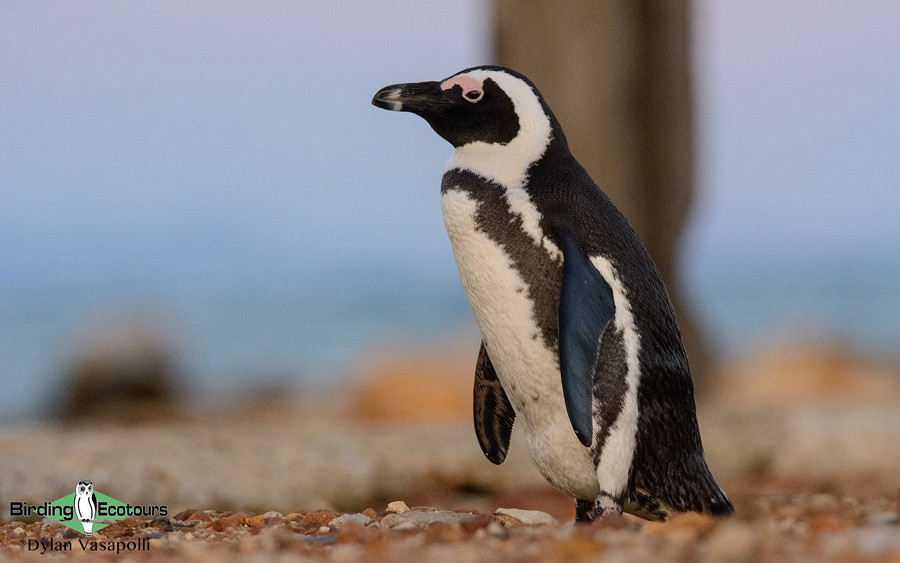
Day 2. Cape Town Pelagic trip (or Cape Peninsula and False Bay birding)
Today is an early start as we embark on a Cape pelagic trip (weather-permitting, otherwise we will spend the day around the Cape Peninsula and False Bay). Soon after leaving the harbor we normally come across large flocks of Cape Cormorants and Cape Gannets heading out to sea to fish for the day, along with the occasional African Penguin. The coastline is incredibly rugged, yet eerily beautiful, with the sharp mountains rising right from the shore. Once we start transiting away from land the serious pelagic birding soon begins as we start seeing good numbers of Sooty, Great, and Cory’s Shearwaters, White-chinned Petrels, and the odd Storm Petrel (Wilson’s and European being most common). As we head farther out we will be on the lookout for trawlers, which attract huge numbers of seabirds. If we do find a trawler it normally has a cloud of seabirds behind it, particularly when the nets are being hauled in. Here we can expect to find Shy, Black-browed, Indian Yellow-nosed and Atlantic Yellow-nosed Albatrosses, Northern and Southern Giant Petrels, Cape Petrel, Brown Skua, and occasionally Great-winged Petrel. We will always be on the lookout for Spectacled Petrel, Northern and Southern Royal Albatrosses, and Wandering Albatross which, although considered rare, are seen with some frequency off the Cape.
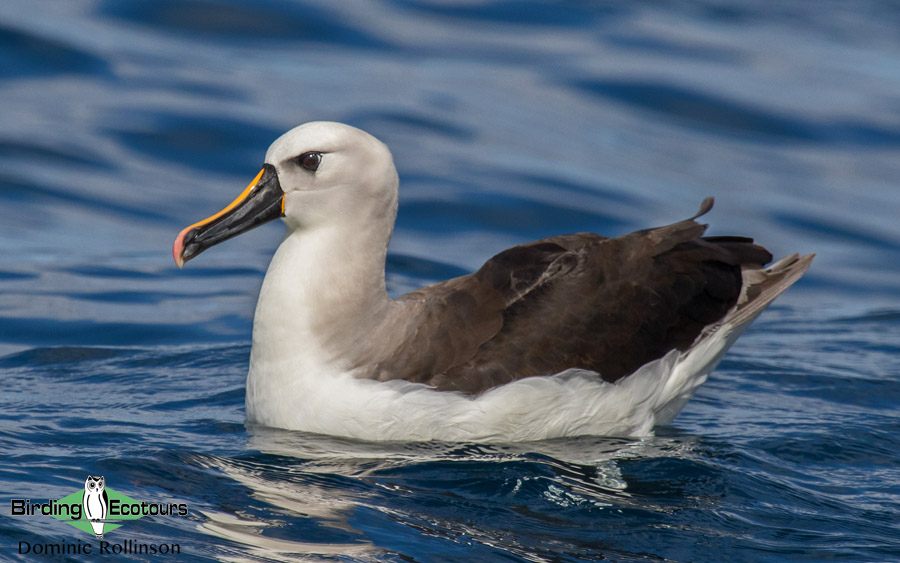
Other marine life to search for include Humpback and Bryde’s Whales as well as Long-beaked Common Dolphin and, if we are extremely lucky, Killer Whale! If possible/already decided, please let us know if you do not want to join the pelagic.
Overnight: Greater Cape Town area
Day 3. Birding the Cape Peninsula and False Bay (or Cape pelagic trip)
Today we plan to visit excellent sites such as the beautiful Hottentot Holland mountain range and Strandfontein Bird Sanctuary, one of Cape Town’s best waterbird sites. We start the day with an early departure (we’ll take breakfast packs along to enjoy later) heading east toward the Hottentot Holland mountains and particularly the small village of Rooi Els. To get to this picturesque village we have to traverse one of the most scenic drives in South Africa along the False Bay coast. First, we drive parallel to an extremely long white beach bordering the Cape Flats that separate the mountainous Cape Peninsula from the inland Cape Fold mountain ranges. Then we reach an area where impressive mountains meet the sea to begin a truly stunning marine drive. Our primary target for the day is Cape Rockjumper, which only occurs in the Cape Fold Mountains. Rooi Els is perhaps the easiest and most accessible spot to see the rockjumper, and our success rates are high. Other species to find here and nearby include Ground Woodpecker, Cape Rock Thrush, Victorin’s Warbler, Cape Siskin, Cape Grassbird, Cape Sugarbird, and many others. We may be lucky with a flyover of the pair of Verreaux’s Eagles that breeds in the area.
We then head to the small town of Betty’s Bay, where we visit the picturesque Harold Porter National Botanical Garden and enjoy lunch after a walk around the gardens. In the gardens we should find African Dusky and African Paradise Flycatchers, Black Saw-wing, Swee Waxbill, Yellow Bishop, and Brimstone and Cape Canaries.
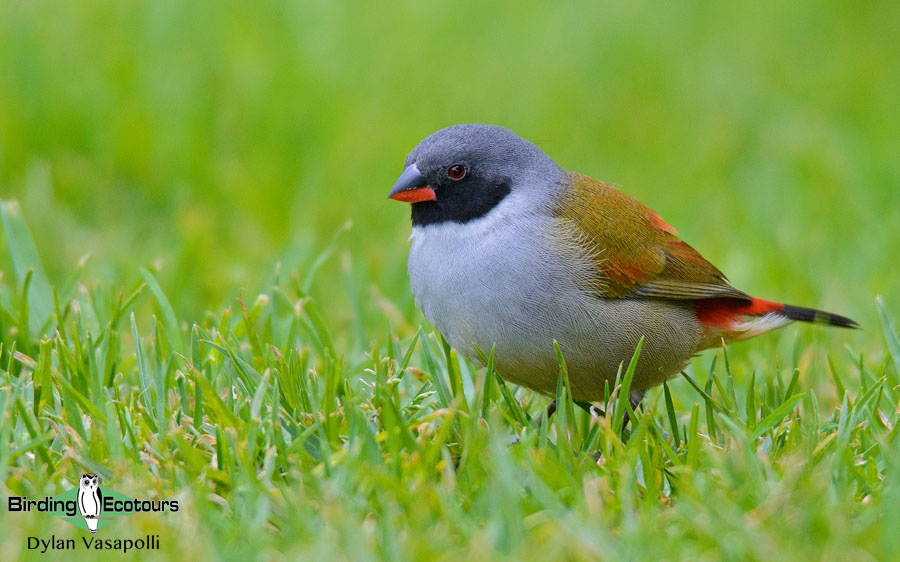
We will also be sure to include a visit to the nearby Stony Point African Penguin colony. In addition to the penguins, Stony Point also has numbers of breeding Cape, Crowned, and Bank Cormorants – all offering excellent and close-up views!
On our way back to Cape Town we may visit Strandfontein Bird Sanctuary, which offers Cape Town’s best wetland birding. Species to look for here include South African Shelduck, Blue-billed, Red-billed, and Cape Teals, Maccoa Duck, Cape Shoveler, Great Crested and Black-necked Grebes, African Swamphen, and a number of other waterbird species.
Overnight: Greater Cape Town area
Day 4. West Coast Birding
Today we head north of Cape Town and travel along the west coast. The strandveld vegetation is subtly different and, with the habitat change, results in a different mix of bird species. We will stop off in some farmlands en route to look for Blue Crane, Pied Starling, Cape Clapper Lark, Capped Wheatear, Cape Longclaw, Pearl-breasted Swallow, and the endemic Cape subspecies of Cloud Cisticola. Birding the strandveld habitat around the West Coast National Park and its surrounding areas will hopefully produce Cape Penduline Tit, Grey Tit, White-backed Mousebird, Bokmakierie, Karoo Scrub Robin, Yellow and White-throated Canaries, Grey-winged Francolin, Southern Black Korhaan, and the striking Black Harrier. We will also spend time at a few of the strategically positioned bird hides along Langebaan Lagoon, one of Africa’s most important shorebird stopover sites. Here we hope to find an assortment of Palearctic shorebirds as well as resident shorebirds, such as Chestnut-banded, White-fronted, and Kittlitz’s Plovers, with the possibility of Osprey and African Fish Eagle overhead. We may have time to look for Langebaan’s resident pair of Verreaux’s Eagles this afternoon; if we run out of time, we will look for them tomorrow morning.
Overnight: Le Mahi Guest House, Langebaan
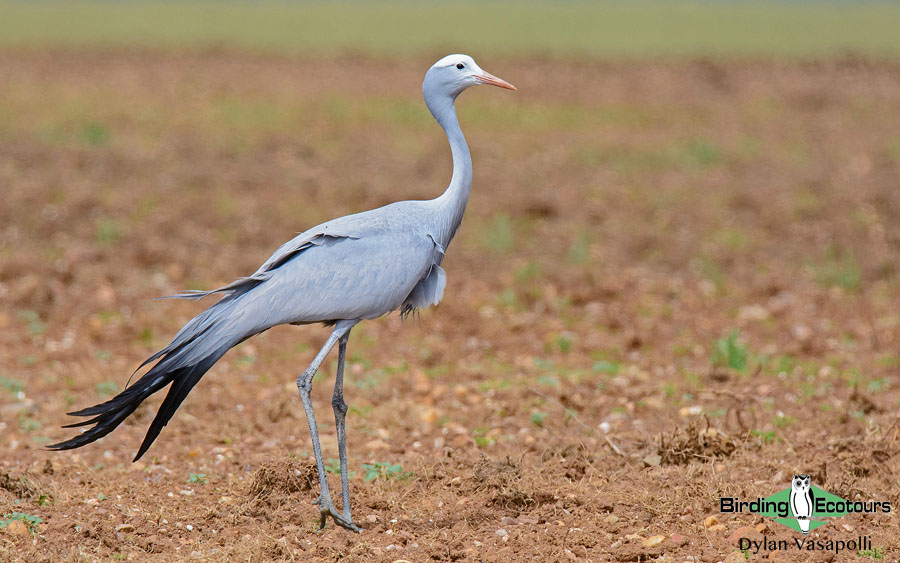
Day 5. Transfer to the Karoo
We often start this day by birding some of the farmlands north of Langebaan for a few more endemics that are unlikely to be found elsewhere on the trip. Our primary targets this morning will be Cape Long-billed Lark and Sickle-winged Chat; however, we should also find Large-billed Lark, Grey-backed Sparrow-Lark, Blue Crane, Ant-eating Chat, and perhaps Namaqua Sandgrouse. After our early-morning birding we head inland through some spectacular mountain scenery. But we have to get to the eastern (rain-shadow) side of the mountains to get to the famed (among birders) Karoo. The Karoo exhibits an amazing level of endemism, as the species need to adapt to the incredibly harsh conditions. This makes for spectacularly exciting birding for any serious birder who has never visited this particular semi-desert.
Overnight: Tankwa Karoo/similar
Day 6. Birding the Karoo
Today we will have a full day of Karoo birding. Dry, rocky gorges will be explored for Cinnamon-breasted Warbler (a truly bizarre rock crevice skulker) as well as Layard’s Warbler, Grey Tit, Fairy Flycatcher, and Booted Eagle overhead. In the riverbed vegetation we will look for another special, Namaqua Warbler. The dry plains will be birded extensively for a range of exciting species such as Rufous-eared Warbler, Black-headed Canary, White-throated Canary, Karoo and Tractrac Chats, Karoo, Spike-heeled, and Large-billed Larks, Karoo Eremomela, Pririt Batis, Ludwig’s Bustard, Karoo Korhaan, Pale Chanting Goshawk, Namaqua Sandgrouse, Namaqua Dove, and many others. The erratic Burchell’s Courser is seen from time to time however sightings of this desert nomad are unfortunately rare and unpredictable. Similarly, depending on unpredictable Karoo rains, Black-eared Sparrow-Lark may sometimes occur in large numbers, however it is only during exceptional years that we see this erratic species, here at its southern extent. We may then head out this evening to search for Freckled and Rufous-cheeked Nightjars and any other exciting nightlife we may encounter.
Overnight: Tankwa Karoo/similar
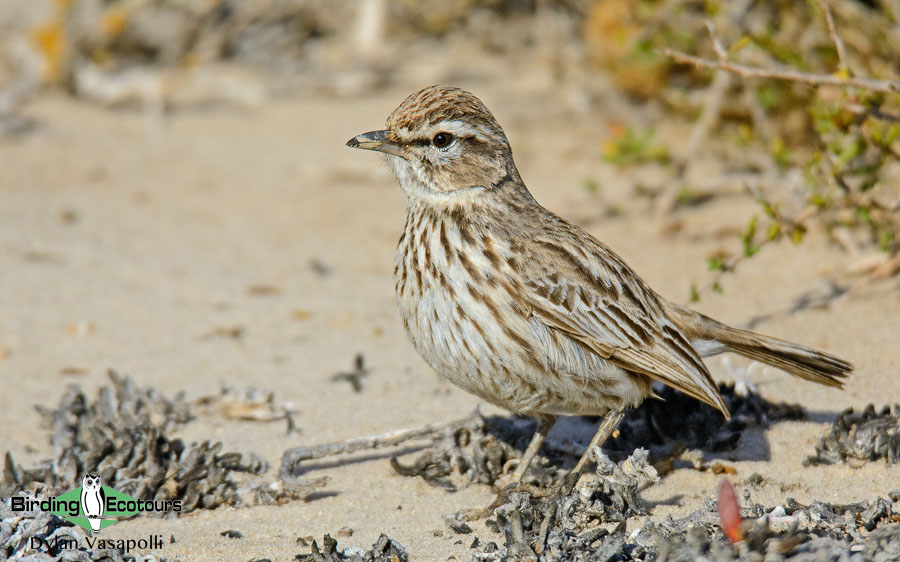
Day 7. Transfer to Cape Town
After some early-morning Karoo birding, searching for anything we have missed over the last couple of days, we head out of the Karoo and back toward Cape Town. On our way back we will stop on a beautiful mountain pass to search for Protea Canary and Victorin’s Warbler and may get lucky with a flyover Verreaux’s Eagle.
Once back in Cape Town we will have part of the afternoon to bird at Kirstenbosch National Botanical Garden. The gardens here are incredibly beautiful, complete with Table Mountain as a backdrop. In the beautifully maintained gardens we will look for Orange-breasted Sunbird and Cape Sugarbird feeding on Protea flowers, while Cape Spurfowl, African Olive Pigeon, Olive Thrush, African Dusky Flycatcher, Cape Batis, Southern Boubou, Cape Canary, Brimstone Canary, Swee Waxbill and Lemon Dove should all be seen while walking around the gardens.
Overnight: Greater Cape Town area
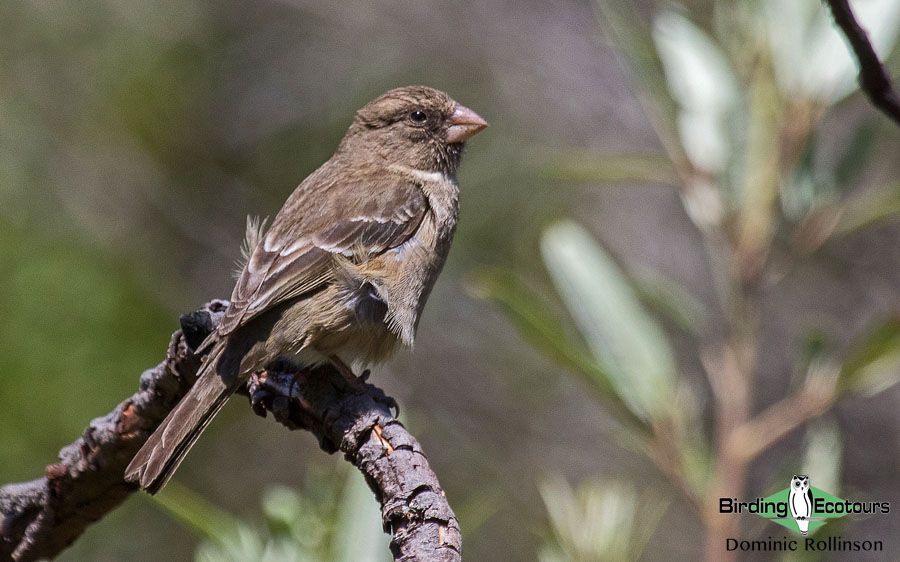
Day 8. Departure
This is the departure day and the tour ends after breakfast, without any further Cape Town birding planned. This tour links up with our Subtropical South Africa birding tour for which we usually catch mid-morning flights to Durban. If you are not joining the Subtropical South Africa tour, you can depart Cape Town at your leisure.
For those joining both these Cape and Subtropical birding trips, the Birding Ecotours office will book the one-way flight from Cape Town to Durban, with everybody on the same flight (this flight cost is excluded from tour prices and usually costs around R2,000-R3,000).
Please note that the itinerary cannot be guaranteed as it is only a rough guide and can be changed (usually slightly) due to factors such as availability of accommodation, updated information on the state of accommodation, roads, or birding sites, the discretion of the guides and other factors. In addition, we sometimes have to use a different international guide from the one advertised due to tour scheduling.
Download ItineraryBest of Cape Town and Beyond Trip Report
7 – 14 OCTOBER 2024
By Joshua Olszewski
DOWNLOAD TRIP REPORT
Overview
This short Cape birding tour was designed to take in some of the Cape’s best birding (targeting just about all of the Cape’s endemics) and included a couple of days in the semi-desert plains of the Tankwa Karoo, while we also enjoyed some fantastic scenery.
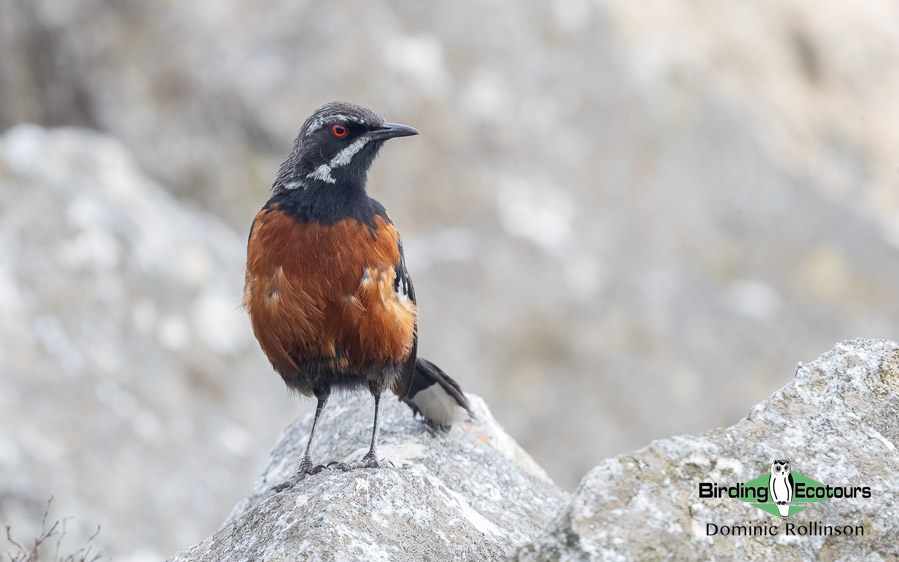
Cape Rockjumpers are always a major highlight of our Cape birding tours.
The tour started with some time in Cape Town where we undertook day trips, before making our way up the west coast to Langebaan and inland through the Cederberg Mountains into the Tankwa Karoo, where we searched for many South African dry country specials. We ended the tour back in beautiful Cape Town where we targeted a few missing species. The trip also included a pelagic trip out of Cape Town, where we got to grips with an array of seabird species, including some rare specials.
Over our week and a bit of Cape birding, we managed an impressive 241 bird species which included many of the Cape’s endemics and specials. Some of our highlights were Grey-winged Francolin, Karoo and Southern Black Korhaans, Namaqua Sandgrouse, African Penguin, Bank, Cape and Crowned Cormorants, Black Harrier, Ground Woodpecker, Cape Rockjumper, Fairy Flycatcher, Grey Tit, Cape Penduline Tit, nine lark species (including many Black-eared Sparrow-Larks), Fairy Flycatcher, Rufous-eared, Cinnamon-breasted and Layard’s Warblers, Cape Sugarbird, Orange-breasted and Dusky Sunbirds and Protea, Forest and Black-headed Canaries.
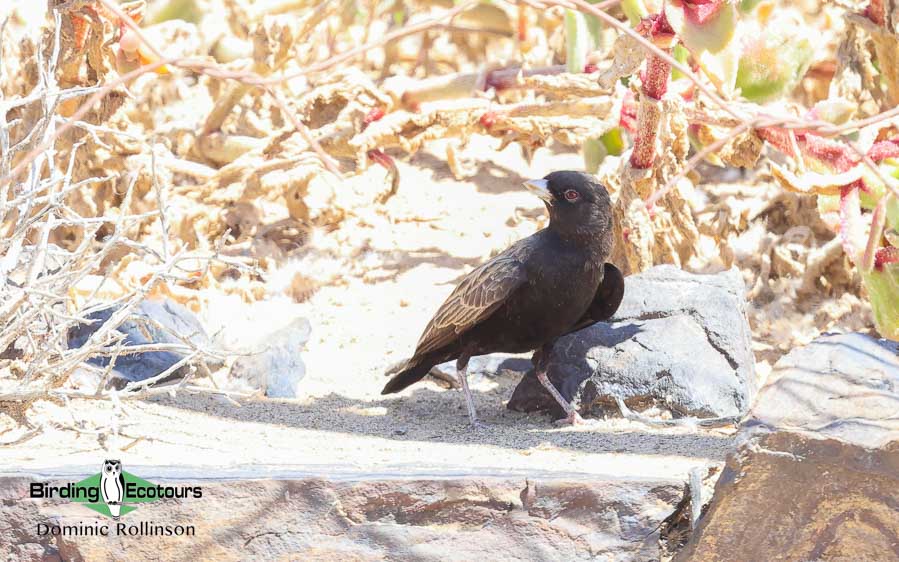
We had many sightings of nomadic Black-eared Sparrow-Larks in the Tankwa Karoo.
Detailed Report
Day 1, 07th October 2024. Arrival in Cape Town and Kirstenbosch birding
After meeting up with the group at our Cape Town accommodation in the early afternoon, we took a short drive across to Kirstenbosch Botanical Gardens. We first had lunch, trying not to get distracted by the tame Ring-necked Doves, Cape Robin-Chats, Cape White-eyes, Cape Bulbuls and Southern Double-collared Sunbirds that were foraging around the tables. After lunch, we took a long but leisurely stroll around the gardens, picking up Cape Sugarbird, Malachite and Amethyst Sunbirds, Cape Batis, Southern Boubou, Sombre Greenbul, African Olive Pigeon, Helmeted Guineafowl, Hadada Ibis, African Paradise Flycatcher, Common Buzzard, Yellow-billed Kite, Black Saw-wing, African Dusky Flycatcher, Speckled Mousebird, Karoo Prinia, Red-winged Starling, Olive Thrush, Cape and Forest Canary and the noisy Cape Spurfowl. A displaying Brown-backed Honeybird was a definite, albeit drab, highlight. Non-avian highlights included a sunbathing Black Girdled Lizard, a highly localized species only found on the Cape Peninsula. We then finished up with point blank views of the resident pair of Spotted Eagle-Owls on a nest, before heading off to dinner. Our final stop for the day was in the suburban greenbelts south of our accommodation, where we were treated to gorgeous views of a vocal African Wood Owl. We also heard a Buff-spotted Flufftail hooting from a nearby thicket, but true to form, it remained invisible to us.
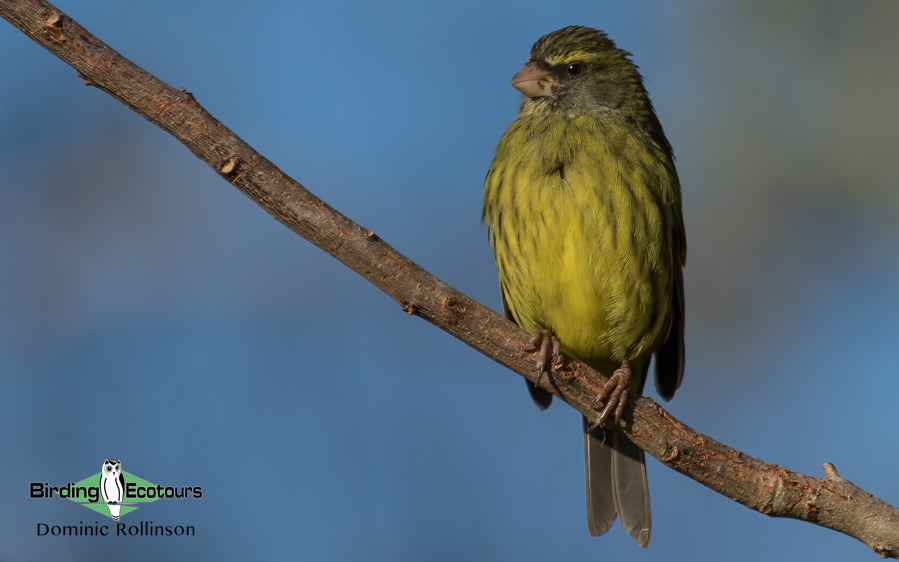
Kirstenbosch Botanical Gardens is always a reliable spot for Forest Canary..
Day 2, 08th October 2024. Rooi-els and Betty’s Bay
We made an early start this morning and headed towards the eastern side of False Bay. En route, we stopped at a roadside gas station which hosted a large breeding colony of bright Southern Red Bishops in the adjacent reedbed. These were accompanied by smaller numbers of both Cape and Southern Masked Weavers, and Glossy Ibis, Blacksmith Lapwing, Laughing and Red-eyed Doves, Speckled Pigeons, and Cape Wagtails were also in evidence. We then pushed on, heading south along the beautiful Clarence Drive which meanders along False Bay’s east coast. We eventually reached our first stop, a boggy mountain stream north of Pringle Bay, by 8am. Here, we hoped to connect with the elusive Striped Flufftail. Sadly, like the Buff-spotted Flufftail from the previous night, it was not meant to be. However, a welcome consolation find was a vocal Burchell’s Coucal bubbling away alongside the creek.
We then backtracked slightly to the neighboring town of Rooi-els, spending a good amount of time birding the scenic Porter Drive. This short gravel road provides brilliant vistas over both False Bay and the surrounding mountains. We soon connected with our main target, the iconic Cape Rockjumper; seeing two males at point blank range was quite a memorable sight. We were also treated to the full suite of mountain fynbos species including Orange-breasted Sunbird, Cape Siskin, Cape Bunting, Grey-backed Cisticola, Cape Sugarbird, Yellow Bishop, Karoo Prinia, Cape Rock-Thrush, Familiar Chat and Cape Grassbird (including an incredibly curious fledgling). Flybys from White-necked Ravens and a Rock Kestrel were also welcomed, as were the Afro-Australasian Fur Seals lounging on the nearby promontory.
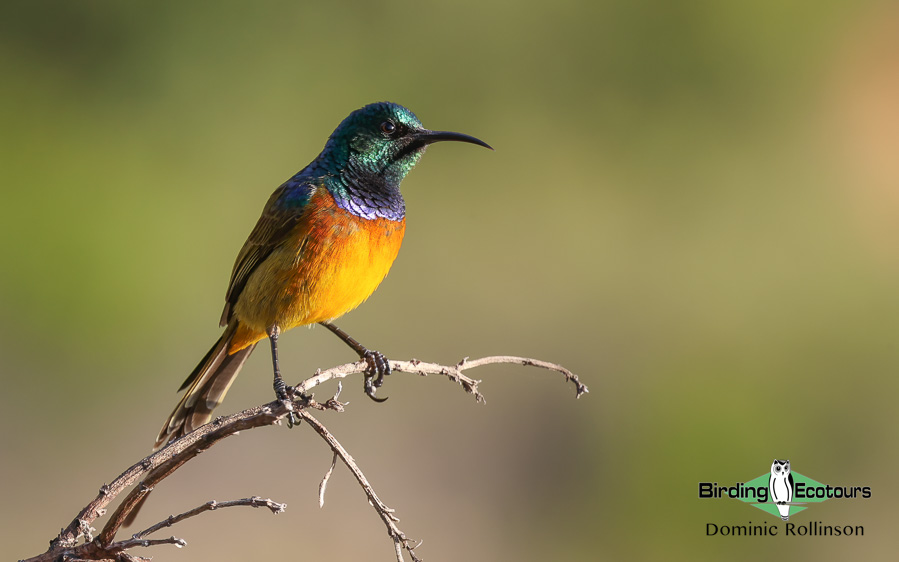
Many exquisitely colored Orange-breasted Sunbirds were seen well in mountain fynbos areas.
A brief coffee stop was made in Rooi-els (where we were entertained by a cheeky Chacma Baboon) before heading over to the Stony Point Penguin Colony in Betty’s Bay. Here we got to witness large numbers of African Penguins, of various ages,resting on the rocks around the coast. These spectacular birds are listed as Endangered by the IUCN, so seeing large numbers of them at the colony is always a treat. The very tip of the promontory plays host to a large cormorant colony, made up mostly of Cape Cormorants in their hundreds. There were also smaller numbers of Crowned, White-breasted and the endangered Bank Cormorant. Other interesting birds seen around the point included Greater Crested, Sandwich and Common Terns, African Oystercatcher, Alpine Swift, a near-shore Northern Giant Petrel and a single Grey-headed Gull loafing with the more common Hartlaub’s and Kelp Gulls. Apart from the birds, the rocks around the promontory were also home to family groups of the peculiar Rock Hyrax, as well as two colorful lizard species: Cape Girdled Lizard and Southern Rock Agama.
Our last stop of the day was the picturesque Harold Porter Botanical Gardens on the east side of Betty’s Bay. Like Kirstenbosch, this reserve consists of manicured floral gardens set at the foothills of dramatic, fynbos-covered mountains. A slow walk around the gardens gave us improved looks at many species we’d seen earlier on, as well as new additions such as Brimstone Canary, Streaky-headed Seedeater, Greater Striped Swallow, Yellow-billed Duck, Neddicky, Swee Waxbill and two high-flying raptors: Jackal Buzzard and Verreaux’s Eagle (the latter being incessantly mobbed by White-necked Ravens). We concluded our time at the gardens with multiple male African Paradise Flycatchers showing off their long, orange tails, before making our way back to Cape Town.
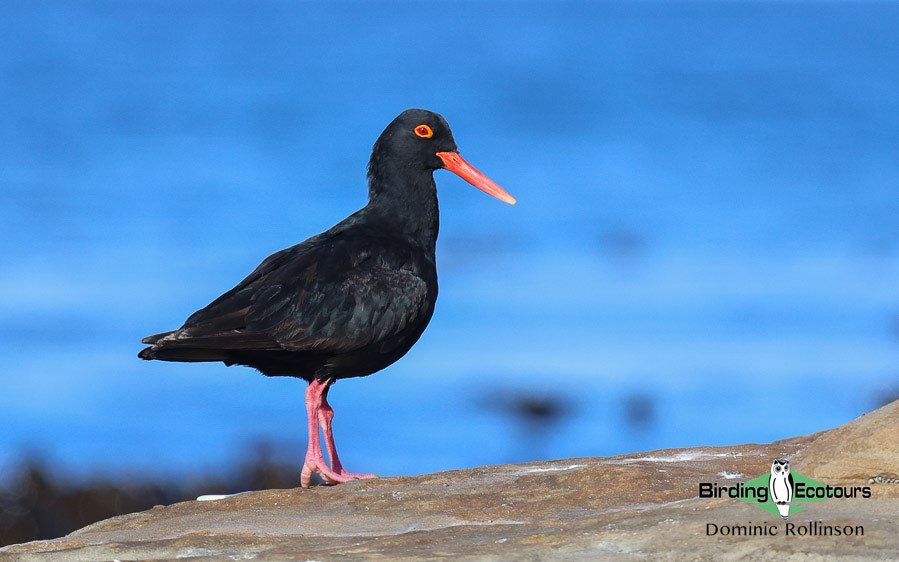
The handsome African Oystercatcher was seen well at Stony Point.
Day 3, 09th October 2024. Pelagic birding off Cape Town
We left our accommodation early, armed with breakfast packs, and met our pelagic guide, Dom, as well as our skipper, Anees, who briefed us on the boat trip ahead and what to expect. As we left Simon’s Town harbor, we saw common coastal species such as Crowned and Cape Cormorants, Greater Crested, Sandwich and Common Terns and Cape Gannet. Thankfully the seas were not too heavy today, and the boat ride was not too uncomfortable (as it often can be). As we rounded Cape Point (enjoying obligatory shots of this scenic spot) the seas became a little choppier and it’s here that we found our first few ‘true pelagic’ species such as Sooty Shearwater, White-chinned Petrel and Shy Albatross.
The word soon came through that a trawler was within reach and so we kept heading southwest towards the trawling grounds where the birds awaited us. From a distance we could see the large numbers of birds swelling behind the trawler and we quickly started picking out further new species such as Sabine’s Gull, Pintado Petrel and Black-browed Albatross. As this trawler was the only fishing vessel within reach today, we decided to stay behind the vessel and simply work through the huge numbers of mostly White-chinned Petrels and various albatrosses.
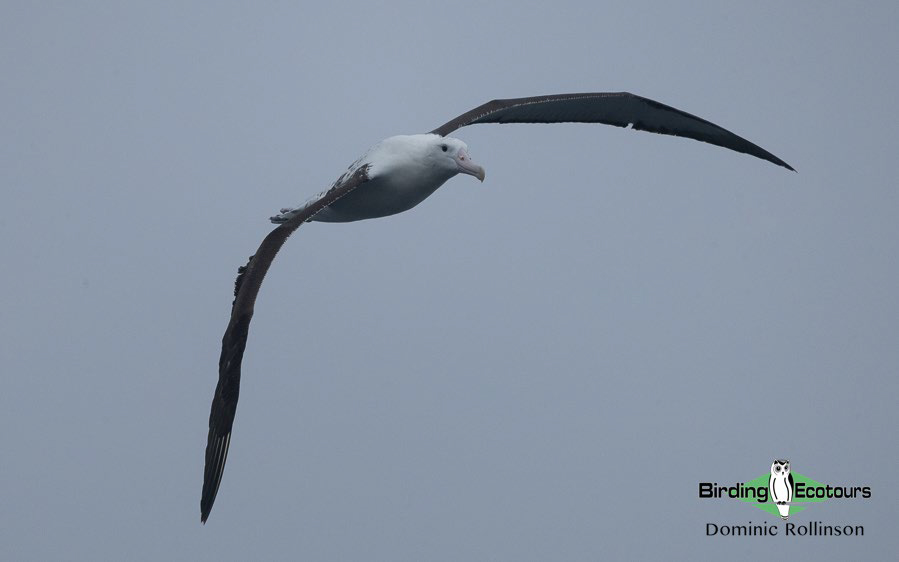
The large “white-back” albatrosses, such as this Northern Royal Albatross, are always a highlight.
We stuck with the trawler for a good couple of hours and during this time we further added Brown Skua, Parasitic Jaeger (brief views), Atlantic and Indian Yellow-nosed Albatrosses, Wilson’s Storm Petrel, Northern Giant Petrel and Great Shearwater. The two stars of the day, however, arrived just before heading back to land and included Southern Fulmar and Northern Royal Albatross which both showed incredibly well for a prolonged period. It was then the long haul back towards Simon’s Town.
Once back in False Bay we stopped to enjoy the nesting group of Bank Cormorants and also had good looks at foraging African Penguins before we returned to the harbor after a highly successful day out at sea.
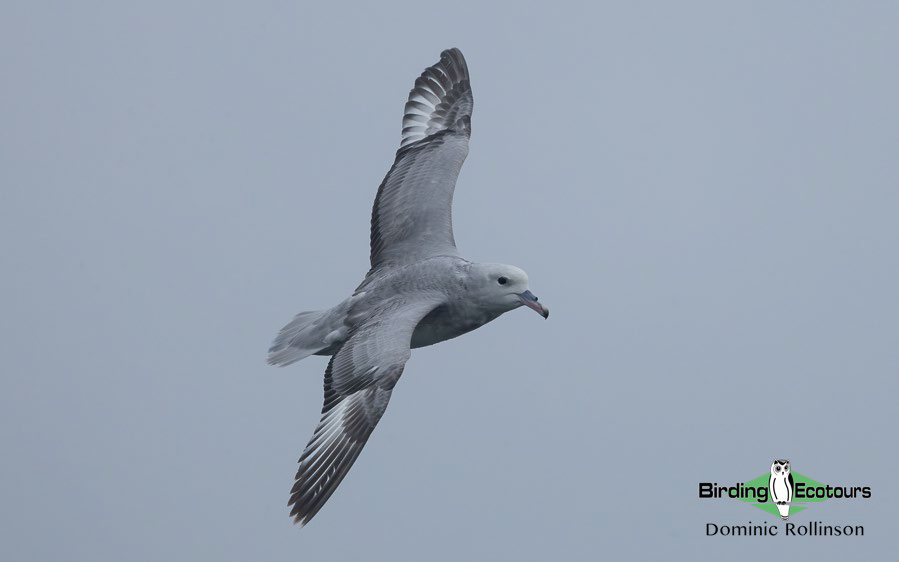
The silvery-white Southern Fulmar was another standout pelagic species.
Day 4, 10th October 2023. Cape Peninsula birding & transfer to Langebaan
After an early checkout from our Cape Town accommodation, we decided to bird some local spots along the Cape Peninsula before heading north along the west coast. Our first port of call was to the nearby Newlands Forest, right next to Kirstenbosch and also set against the moist, forested, eastern slope of Table Mountain. Three notable additions to the trip list here were Lemon Dove, Olive Woodpecker and a soaring Forest Buzzard (the latter is rare and unreliable around Cape Town). We also spotted a displaying African Goshawk flying high overhead and connected with the local introduced population of Eurasian Chaffinch. After Newlands, we popped in at the Rondebosch Common: a public park surrounded by bustling main roads. However, this park has hosted a breeding pair of Rufous-breasted Sparrowhawks for many years now, and we took no time in connecting with the showy male. We also got great views of Zitting Cisticola and our first Southern Fiscal of the trip. Traveling south, we had split-second views of a Peregrine Falcon shooting over the road before arriving at the Tokai pine forest, yet another public park. This one hosted a breeding pair of Black Sparrowhawks, and the adult female and one of her newly fledged offspring were quite obliging and showed very well. A singing Lesser Honeyguide was also a great find here.
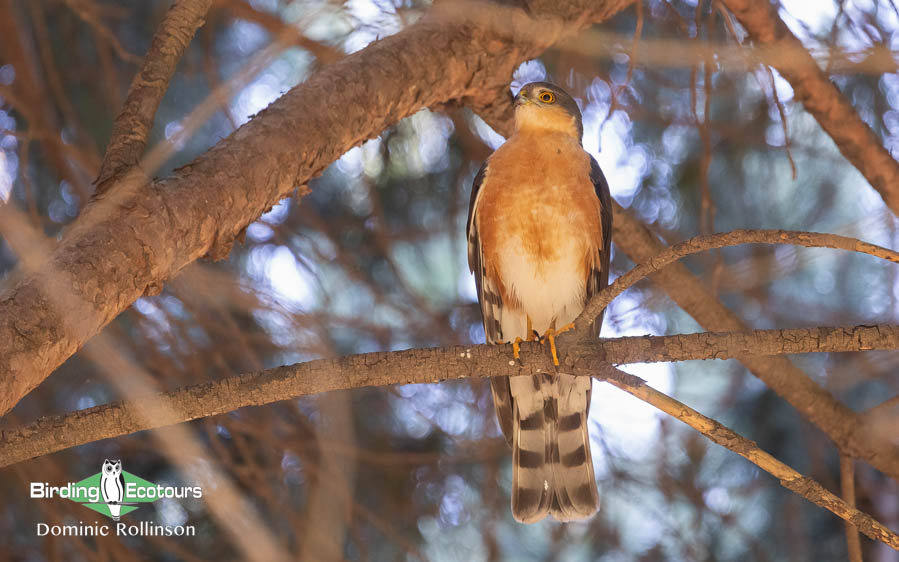
The showy pair of Rufous-breasted Sparrowhawks gave us excellent looks near Cape Town.
After a quick park-side breakfast, we started journeying north towards the west coast, making quite a few birding stops as we went. We first paid a visit to some roadside wetlands just north of Cape Town. Between a number of these, we connected with an array of waterbirds including Great Crested and Black-necked Grebe, Maccoa Duck, White-backed Duck, Cape Shoveler, Red-billed Teal, Cape Teal, Southern Pochard, Greater and Lesser Flamingo, Little Egret, Reed Cormorant, Whiskered and Caspian Tern, Red-knobbed Coot, Black-winged Stilt, Grey Heron, Common Greenshank and African Jacana (a local rarity). Other new birds seen around these wetlands included White-backed Mousebird, Levaillant’s Cisticola, Lesser Swamp Warbler, White-throated Swallow, Brown-throated Martin, and Common Waxbill. We then continued northwards, stopping at a nearby eucalyptus plantation that delivered a male Greater Honeyguide. We then connected with our first Blue Crane strutting through a roadside farm field. This field also gave us our first views of Red-capped Lark and African Pipit for the trip.
Once we made it into the rolling, scrubby dunes of the west coast strandveld, we started looking for a host of new species that had become available to us. A number of roadside stops in this habitat produced Pearl-breasted Swallow, Bokmakierie, Bar-throated Apalis, Karoo Scrub Robin, Chestnut-vented Warbler, Cape Sparrow, African Hoopoe, Capped Wheatear, Cloud Cisticola (which showed unusually well), a stunning male Southern Black Korhaan and a number of raptor species: Black-winged Kite, Rock Kestrel, Jackal Buzzard, Booted Eagle, African Marsh Harrier and a striking Black Harrier! After checking in and having a great dinner in the coastal town of Langebaan, we made a brief stop outside of town where we found a male Fiery-necked Nightjar singing away (and flying within inches of our faces!).
Day 5: 11th October 2023. Birding the west coast and transfer to the Tankwa Karoo
Our first birding stop of the morning was the Langebaan Country Estate, which, in spite of its lavish housing complex, contains some well-preserved strandveld which delivered a number of our target species. Cape Clapper Larks displayed all over the grassy hillside, and a Cape Long-billed Lark treated us to its nose-dive display, before perching proudly for us to enjoy. A pair of Grey-winged Francolins with a tiny chick were also a great find, as were a number of Banded Martins flying around with the more common Greater Striped Swallows and Large Rock Martins. Our first looks at Yellow and White-throated Canary, Karoo Scrub Robin, African Stonechat, Large-billed Lark and African Black Swift were also had at the estate. We also had more Southern Black Korhaans for some extra eye-candy.
Venturing from the estate into the renowned West Coast National Park, we first stopped at the Seeberg bird hide near the northern entrance gate. The high tide at the time allowed for great views and photographic opportunities of the coastal birds that were roosting and feeding along the beach here. These included large numbers of Kelp and Hartlaub’s Gulls, White-breasted, Crowned and Cape Cormorants, African Oystercatchers, Sanderlings, Eurasian Whimbrels, Bar-tailed Godwits, Common and Sandwich Terns and Greater and Lesser Flamingos. From these, we picked out smaller numbers of Grey, White-fronted, Common Ringed and Kittlitz’s Plovers, Curlew Sandpiper, Little Stint, Greater Crested and Caspian Tern, Common Greenshank and singletons of Eurasian Curlew and Little Tern. The scrub surrounding the hide was also quite productive and gave us Grey Tit, Cape Penduline-Tit, Red-faced Mousebird, Malachite Sunbird, Cape Bunting, Chestnut-vented Warbler, European Bee-eater, Cape Grassbird and Pearl-breasted Swallow.
From Seeberg we drove south through the park, spotting Common Ostrich and multiple African Marsh Harriers as we went (including one having an altercation with a Black Harrier). We then arrived at the Geelbek manor house at the southern tip of the Langebaan lagoon. The trees around the house produced Pied Starling, Southern Grey-headed Sparrows, a confiding Rock Kestrel and the diminutive Cardinal Woodpecker, while the saltmarsh surrounding the lagoon delivered a lot of the afore-mentioned waterbirds, with the addition of Marsh Sandpiper. The nearby Abramskraal waterhole was also very enjoyable for us. Here we enjoyed large numbers of Cape Weavers and Namaqua Doves, a showy African Spoonbill, skulking Lesser Swamp Warblers and a brief Black Crake. After exiting the park, we made one last stop at the Langebaan Quarry to enjoy the local pair of Verreaux’s Eagles that breed here, while also connecting with our first Three-banded Plovers.
After enjoying the birding on the west coast, we made our way east, crossing vast tracks of farmland and scenic mountain passes before entering into the Karoo around dusk. We then turned in early and awaited the next full day of birding this dry desert region of western South Africa.
Day 6, 12th October 2023. Tankwa Karoo birding
We had the full day to explore the dry gorges and plains of the Tankwa Karoo today and had a long list of target birds to aim for. We started the day by birding around our guest farm and the nearby Skitterykloof which added many of our dry country targets, the first of which included Karoo Lark, Rufous-eared Warbler, Mountain Wheatear, Layard’s Warbler, Pririt Batis, Fairy Flycatcher, Karoo Chat, Pale Chanting Goshawk, Lark-like Bunting, Dusky Sunbird, and White-throated, Yellow and Black-headed Canary. Some interesting extras seen around here included Common Reed Warbler, Long-billed Crombec, Common Waxbill and another pair of Grey-winged Francolins with chicks.
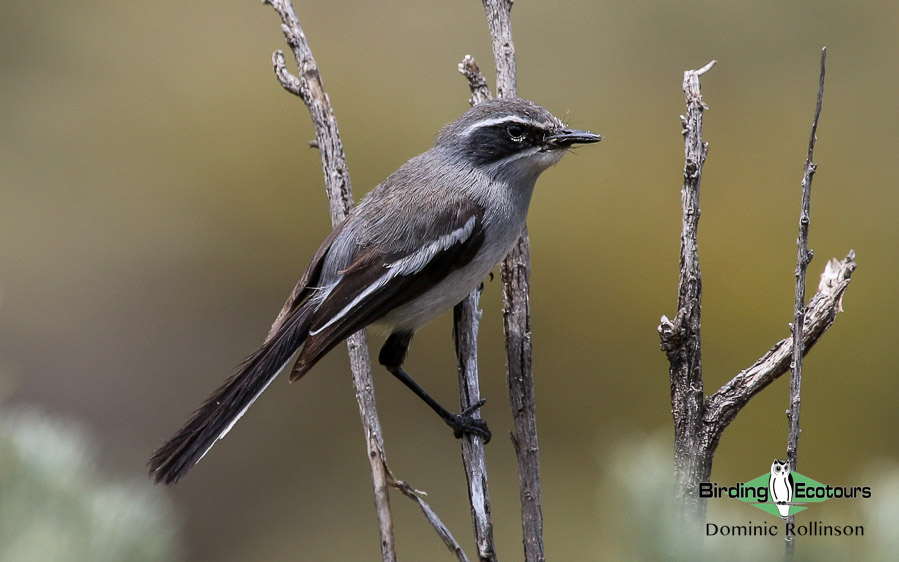
The tiny Fairy Flycatcher is commonly found in the Tankwa Karoo.
We then headed back towards the main Tankwa-Ceres road, crossing a narrow riverbed that, surprisingly, was holding water! As a result, we were treated to small numbers of Namaqua Sangrouse coming down to drink, and also had great looks at White-throated Canary, Lark-like Bunting, Familiar Chat, Chestnut-vented Warbler and a soaring Booted Eagle. Heading north along the main road, we managed to pick up Tractrac Chats and a Lanner Falcon on roadside fenceposts, as well as Namaqua Warbler in the riverbed north of the Tankwa Padstal. We then returned to our lodge to relax and kill the heat of the day.
Once the temperature had started to lower, we ventured out for a late afternoon drive, spotting another Black Harrier as we left the lodge premises. Once again heading north, we pushed on passed the padstal and scanned the barren plains along the roadside. This turned out to be quite productive, and over the next few hours we managed to connect with small numbers of Large-billed, Red-capped and Spike-heeled Larks, as well as the nomadic Black-eared Sparrow-Lark. The males of these small larks are quite noticeable in flight with their jet-black plumage and were a real highlight of the day. Another was a small group of Karoo Eremomelas at one of the arbitrary picnic tables along this road. We were also fortunate enough to bump into not just one, but two groups of Karoo Korhaans, the later group being particularly close to us, and with a young chick in tow! A final pop-in at Skitterykloof before dinnertime gave us Pale-winged Starlings, improved views of Black-headed Canary and an Ant-eating Chat outside our accommodation. A final surprise for the day was a Frecked Nightjar that flushed from next to one of the client’s chalets, as well as a Cape Genet perched on the rocks above said chalet.
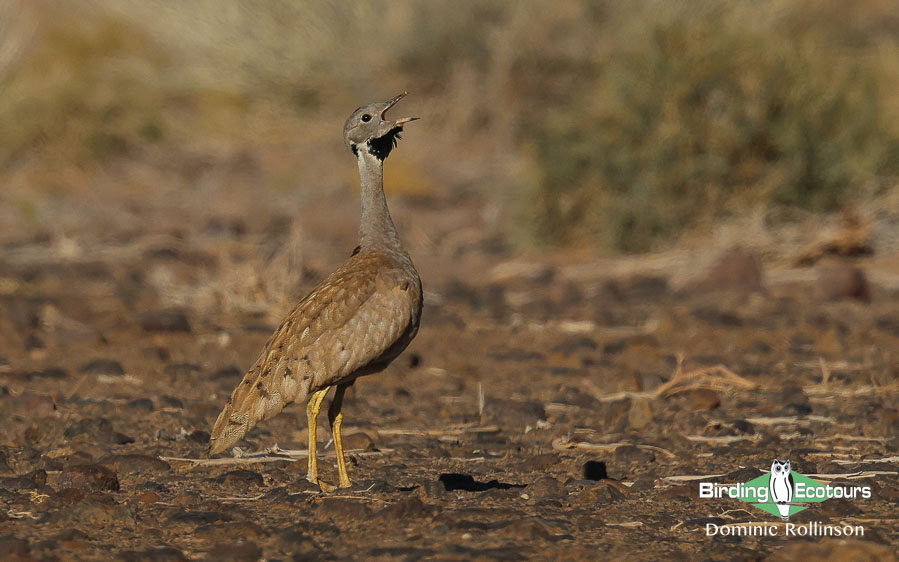
Karoo Korhaans gave us lovely looks in the Tankwa Karoo.
Day 7, 13th October 2024. Tankwa karoo birding and transfer to Cape Town
This morning saw us make a final attempt at Skitterykloof for one of our major Karoo targets that had been evading us. Eventually, they gave themselves us: a pair of Cinnamon-breasted Warblers mutually preening each other low down on the roadside slope! We also had our best views of Black Harrier here, with one providing prolonged soaring views low overhead. The other individual, presumably the male, entertained us with his noisy fluttering display flight nearby. With all the main targets secured, we decided to venture further west along the Skitterykloof road. As the pass winds on towards the mountains, the vegetation rapidly changes from normal Karoo scrub to transitional Karroid Fynbos. This was reflected by the sudden appearance of Southern Black Korhaans and Cape Clapper Larks displaying along the road, as well as protea bushes. These bushes delivered Cape Sugarbirds and, soon after, an obliging Protea Canary, another fynbos endemic and a major target for this tour!
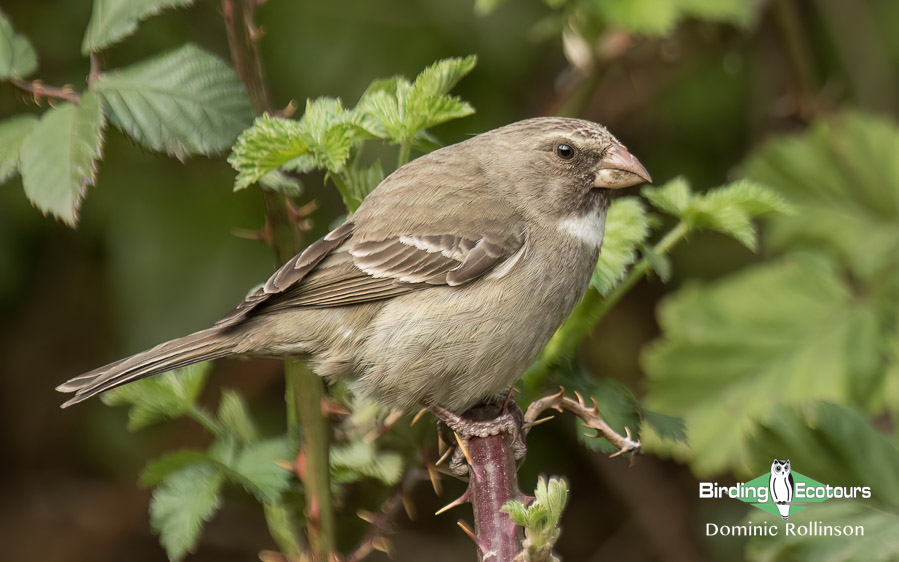
The often-tricky Protea Canary played along for us this time round.
After the success with the canary, we made our way east again, down the Skitterykloof pass and south along the main Tankwa road towards Ceres. We did some light Karoo birding in the plains along the road, stopping briefly to scan the immense dam just south of Eierkop. Here we once again found massive numbers of waterbirds, which included thousands of Greater Flamingos, Red-knobbed Coots and Black-necked Grebes. Small groups of Glossy Ibis, White-faced Whistling Ducks and the handsome South African Shelduck were welcome new trip additions, as were an obliging pair of Sickle-winged Chats. The adorable Brants’ Whistling Rat was also great to see (and not just hear, for a change!). Seeing flocks of Whiskered Terns flying around in the middle of a desert was also quite strange!
One Booted Eagle and another Black Harrier later, we were back in Ceres, where we fueled up and started on the long drive back towards Cape Town. We made a few stops as we went, which got us some new species like African Black Duck, Spotted Thick-knee, African Darter, Acacia Pied Barbet and Pin-tailed Whydah. A distant Cape Rockjumper near Paarl and a family of Blue Cranes with chicks were welcome surprises. Venturing towards False Bay, we managed to find a group of European Bee-eaters that provided excellent photographic opportunities right next to the road. After which, we arrived at the famous Standfontein Sewage Works. This, one of the most popular birding sites in the Western Cape, is a mecca for waterbirds, and we took the time to enjoy the hundreds of gulls, ducks, flamingos, coots, ibis and herons that live here. Species-wise, we added Little Rush Warbler and Black-crowned Night Heron, as well as the vagrant Franklin’s Gull that had been hanging around this spot for the previous week. A small group of Marsh Sandpipers was another notable find here. We then returned to Fernwood Manor and enjoyed a hearty dinner in town, reflecting on the incredible week of birding we had just completed.
Day 8, 14th October 2024. Cape Town birding and departure
Today was simply a travel day, as most of the clients were flying out in the evening or the following day.
This ended a highly successful and thoroughly enjoyable week’s birding in the Cape. Thanks everybody for making it such a fun trip.
Bird List – Following IOC (September 2024)
Birds ‘heard only’ are marked with (H) after the common name, birds seen by the guide only are marked with a (G) after the common name, all other species were seen both by clients and guide.
The following notation after species names is used to show conservation status following BirdLife International. EN = Endangered, VU = Vulnerable, NT = Near-Threatened.
| Common Name | Scientific Name |
| Ostriches (Struthionidae) | |
| Common Ostrich | Struthio camelus |
| Ducks, Geese, Swans (Anatidae) | |
| White-faced Whistling Duck | Dendrocygna viduata |
| White-backed Duck | Thalassornis leuconotus |
| Spur-winged Goose | Plectropterus gambensis |
| Egyptian Goose | Alopochen aegyptiaca |
| South African Shelduck | Tadorna cana |
| Cape Shoveler | Spatula smithii |
| African Black Duck | Anas sparsa |
| Yellow-billed Duck | Anas undulata |
| Cape Teal | Anas capensis |
| Red-billed Teal | Anas erythrorhyncha |
| Southern Pochard | Netta erythrophthalma |
| Maccoa Duck – EN | Oxyura maccoa |
| Guineafowl (Numididae) | |
| Helmeted Guineafowl | Numida meleagris |
| Pheasants & Allies (Phasianidae) | |
| Grey-winged Francolin | Scleroptila afra |
| Common Quail (H) | Coturnix coturnix |
| Cape Spurfowl | Pternistis capensis |
| Nightjars (Caprimulgidae) | |
| Fiery-necked Nightjar | Caprimulgus pectoralis |
| Freckled Nightjar | Caprimulgus tristigma |
| Swifts (Apodidae) | |
| Alpine Swift | Tachymarptis melba |
| African Black Swift | Apus barbatus |
| Little Swift | Apus affinis |
| White-rumped Swift | Apus caffer |
| Bustards (Otididae) | |
| Karoo Korhaan | Heterotetrax vigorsii |
| Southern Black Korhaan – VU | Afrotis afra |
| Cuckoos (Cuculidae) | |
| Burchell’s Coucal | Centropus burchellii |
| Klaas’s Cuckoo | Chrysococcyx klaas |
| Sandgrouse (Pteroclidae) | |
| Namaqua Sandgrouse | Pterocles namaqua |
| Pigeons, Doves (Columbidae) | |
| Rock Dove | Columba livia |
| African Olive Pigeon | Columba arquatrix |
| Speckled Pigeon | Columba guinea |
| Lemon Dove | Columba larvata |
| Red-eyed Dove | Streptopelia semitorquata |
| Ring-necked Dove | Streptopelia capicola |
| Laughing Dove | Spilopelia senegalensis |
| Namaqua Dove | Oena capensis |
| Flufftails & Forest Rails (Sarothruridae) | |
| Buff-spotted Flufftail (H) | Sarothrura elegans |
| Red-chested Flufftail (H) | Sarothrura rufa |
| Rails, Crakes & Coots (Rallidae) | |
| African Rail (H) | Rallus caerulescens |
| Common Moorhen | Gallinula chloropus |
| Red-knobbed Coot | Fulica cristata |
| African Swamphen | Porphyrio madagascariensis |
| Black Crake | Zapornia flavirostra |
| Cranes (Gruidae) | |
| Blue Crane – VU | Grus paradisea |
| Grebes (Podicipedidae) | |
| Little Grebe | Tachybaptus ruficollis |
| Great Crested Grebe | Podiceps cristatus |
| Black-necked Grebe | Podiceps nigricollis |
| Flamingos (Phoenicopteridae) | |
| Greater Flamingo | Phoenicopterus roseus |
| Lesser Flamingo | Phoeniconaias minor |
| Stone-curlews, Thick-knees (Burhinidae) | |
| Spotted Thick-knee | Burhinus capensis |
| Water Thick-knee (H) | Burhinus vermiculatus |
| Oystercatchers (Haematopodidae) | |
| African Oystercatcher | Haematopus moquini |
| Stilts, Avocets (Recurvirostridae) | |
| Black-winged Stilt | Himantopus himantopus |
| Pied Avocet | Recurvirostra avosetta |
| Plovers (Charadriidae) | |
| Blacksmith Lapwing | Vanellus armatus |
| Crowned Lapwing | Vanellus coronatus |
| Grey Plover | Pluvialis squatarola |
| Common Ringed Plover | Charadrius hiaticula |
| Kittlitz’s Plover | Charadrius pecuarius |
| Three-banded Plover | Charadrius tricollaris |
| White-fronted Plover | Charadrius marginatus |
| Jacanas (Jacanidae) | |
| African Jacana | Actophilornis africanus |
| Sandpipers, Snipes (Scolopacidae) | |
| Eurasian Whimbrel | Numenius phaeopus |
| Eurassian Curlew | Numenius arquata |
| Bar-tailed Godwit | Limosa lapponica |
| Curlew Sandpiper | Calidris ferruginea |
| Sanderling | Calidris alba |
| Little Stint | Calidris minuta |
| Marsh Sandpiper | Tringa stagnatilis |
| Common Greenshank | Tringa nebularia |
| Gulls, Terns, Skimmers (Laridae) | |
| Little Tern | Sternula albifrons |
| Caspian Tern | Hydroprogne caspia |
| Whiskered Tern | Chlidonias hybrida |
| Common Tern | Sterna hirundo |
| Sandwich Tern | Thalasseus sandvicensis |
| Greater Crested Tern | Thalasseus bergii |
| Sabine’s Gull | Xema sabini |
| Grey-headed Gull | Chroicocephalus cirrocephalus |
| Hartlaub’s Gull | Chroicocephalus hartlaubii |
| Franklin’s Gull | Leucophaeus pipixcan |
| Kelp Gull | Larus dominicanus |
| Skuas (Stercorariidae) | |
| Parasitic Jaeger | Stercorarius parasiticus |
| Brown Skua | Stercorarius antarcticus |
| Penguins (Spheniscidae) | |
| African Penguin – EN | Spheniscus demersus |
| Austral Storm Petrels (Oceanitidae) | |
| Wilson’s Storm Petrel | Oceanites oceanicus |
| Albatrosses (Diomedeidae) | |
| Northern Royal Albatross – EN | Diomedea sanfordi |
| Atlantic Yellow-nosed Albatross – EN | Thalassarche chlororhynchos |
| Indian Yellow-nosed Albatross – EN | Thalassarche carteri |
| Shy Albatross | Thalassarche cauta |
| Black-browed Albatross – EN | Thalassarche melanophris |
| Petrels, Shearwaters, Diving Petrels (Procellariidae) | |
| Northern Giant Petrel | Macronectes halli |
| White-chinned Petrel – VU | Procellaria aequinoctialis |
| Southern Fulmar | Fulmarus glacialoides |
| Cape Petrel | Daption capense |
| Sooty Shearwater | Ardenna grisea |
| Great Shearwater | Ardenna gravis |
| Gannets, Boobies (Sulidae) | |
| Cape Gannet – EN | Morus capensis |
| Anhingas, Darters (Anhingidae) | |
| African Darter | Anhinga rufa |
| Cormorants, Shags (Phalacrocoracidae) | |
| Reed Cormorant | Microcarbo africanus |
| Crowned Cormorant | Microcarbo coronatus |
| Bank Cormorant – EN | Phalacrocorax neglectus |
| Cape Cormorant – EN | Phalacrocorax capensis |
| White-breasted Cormorant | Phalacrocorax lucidus |
| Ibises, Spoonbills (Threskiornithidae) | |
| African Sacred Ibis | Threskiornis aethiopicus |
| Hadada Ibis | Bostrychia hagedash |
| Glossy Ibis | Plegadis falcinellus |
| African Spoonbill | Platalea alba |
| Herons, Bitterns (Ardeidae) | |
| Black-crowned Night Heron | Nycticorax nycticorax |
| Little Egret | Egretta garzetta |
| Western Cattle Egret | Bubulcus ibis |
| Grey Heron | Ardea cinerea |
| Black-headed Heron | Ardea melanocephala |
| Pelicans (Pelecanidae) | |
| Great White Pelican | Pelecanus onocrotalus |
| Kites, Hawks, Eagles (Accipitridae) | |
| Black-winged Kite | Elanus caeruleus |
| Martial Eagle – EN | Polemaetus bellicosus |
| Booted Eagle | Hieraaetus pennatus |
| Verreaux’s Eagle | Aquila verreauxii |
| Pale Chanting Goshawk | Melierax canorus |
| African Goshawk | Accipiter tachiro |
| Rufous-breasted Sparrowhawk | Accipiter rufiventris |
| Black Sparrowhawk | Accipiter melanoleucus |
| African Marsh Harrier | Circus ranivorus |
| Black Harrier – EN | Circus maurus |
| Yellow-billed Kite | Milvus aegyptius |
| Jackal Buzzard | Buteo rufofuscus |
| Forest Buzzard | Buteo trizonatus |
| Owls (Strigidae) | |
| Spotted Eagle-Owl | Bubo africanus |
| African Wood Owl | Strix woodfordii |
| Mousebirds (Coliidae) | |
| Speckled Mousebird | Colius striatus |
| White-backed Mousebird | Colius colius |
| Red-faced Mousebird | Urocolius indicus |
| Hoopoes (Upupidae) | |
| African Hoopoe | Upupa africana |
| Bee-eaters (Meropidae) | |
| European Bee-eater | Merops apiaster |
| Honeyguides (Indicatoridae) | |
| Brown-backed Honeybird | Prodotiscus regulus |
| Lesser Honeyguide | Indicator minor |
| Greater Honeyguide | Indicator indicator |
| African Barbets (Lybiidae) | |
| Acacia Pied Barbet | Tricholaema leucomelas |
| Woodpeckers (Picidae) | |
| Ground Woodpecker | Geocolaptes olivaceus |
| Cardinal Woodpecker | Dendropicos fuscescens |
| Olive Woodpecker | Dendropicos griseocephalus |
| Caracaras, Falcons (Falconidae) | |
| Rock Kestrel | Falco rupicolus |
| Lanner Falcon | Falco biarmicus |
| Peregrine Falcon | Falco peregrinus |
| Wattle-eyes, Batises (Platysteiridae) | |
| Cape Batis | Batis capensis |
| Pririt Batis | Batis pririt |
| Bushshrikes (Malaconotidae) | |
| Bokmakierie | Telophorus zeylonus |
| Southern Boubou | Laniarius ferrugineus |
| Drongos (Dicruridae) | |
| Fork-tailed Drongo | Dicrurus adsimilis |
| Monarchs (Monarchidae) | |
| African Paradise Flycatcher | Terpsiphone viridis |
| Shrikes (Laniidae) | |
| Southern Fiscal | Lanius collaris |
| Crows, Jays (Corvidae) | |
| Pied Crow | Corvus albus |
| White-necked Raven | Corvus albicollis |
| Rockjumpers (Chaetopidae) | |
| Cape Rockjumper | Chaetops frenatus |
| Fairy Flycatchers (Stenostiridae) | |
| Fairy Flycatcher | Stenostira scita |
| Tits, Chickadees (Paridae) | |
| Grey Tit | Melaniparus afer |
| Penduline Tits (Remizidae) | |
| Cape Penduline Tit | Anthoscopus minutus |
| Larks (Alaudidae) | |
| Spike-heeled Lark | Chersomanes albofasciata |
| Cape Long-billed Lark | Certhilauda curvirostris |
| Black-eared Sparrow-Lark | Eremopterix australis |
| Grey-backed Sparrow-Lark | Eremopterix verticalis |
| Karoo Lark | Calendulauda albescens |
| Cape Clapper Lark | Mirafra apiata |
| Large-billed Lark | Galerida magnirostris |
| Red-capped Lark | Calandrella cinerea |
| Bulbuls (Pycnonotidae) | |
| Sombre Greenbul | Andropadus importunus |
| Cape Bulbul | Pycnonotus capensis |
| Swallows, Martins (Hirundinidae) | |
| Black Saw-wing | Psalidoprocne pristoptera |
| Banded Martin | Neophedina cincta |
| Brown-throated Martin | Riparia paludicola |
| Large Rock Martin | Ptyonoprogne fuligula |
| Pearl-breasted Swallow | Hirundo dimidiata |
| White-throated Swallow | Hirundo albigularis |
| Greater Striped Swallow | Cecropis cucullata |
| Crombecs, African Warblers (Macrosphenidae) | |
| Cape Grassbird | Sphenoeacus afer |
| Long-billed Crombec | Sylvietta rufescens |
| Reed Warblers & Allies (Acrocephalidae) | |
| Lesser Swamp Warbler | Acrocephalus gracilirostris |
| Common Reed Warbler | Acrocephalus scirpaceus |
| Grassbirds & Allies (Locustellidae) | |
| Little Rush Warbler | Bradypterus baboecala |
| Cisticolas & Allies (Cisticolidae) | |
| Grey-backed Cisticola | Cisticola subruficapilla |
| Levaillant’s Cisticola | Cisticola tinniens |
| Neddicky | Cisticola fulvicapilla |
| Zitting Cisticola | Cisticola juncidis |
| Cloud Cisticola | Cisticola textrix |
| Karoo Prinia | Prinia maculosa |
| Namaqua Warbler | Phragmacia substriata |
| Bar-throated Apalis | Apalis thoracica |
| Rufous-eared Warbler | Malcorus pectoralis |
| Cinnamon-breasted Warbler | Euryptila subcinnamomea |
| Karoo Eremomela | Eremomela gregalis |
| Sylviid Babblers (Sylviidae) | |
| Layard’s Warbler | Curruca layardi |
| Chestnut-vented Warbler | Curruca subcoerulea |
| White-eyes (Zosteropidae) | |
| Cape White-eye | Zosterops virens |
| Sugarbirds (Promeropidae) | |
| Cape Sugarbird | Promerops cafer |
| Starlings, Rhabdornises (Sturnidae) | |
| Common Starling | Sturnus vulgaris |
| Pied Starling | Lamprotornis bicolor |
| Red-winged Starling | Onychognathus morio |
| Pale-winged Starling | Onychognathus nabouroup |
| Thrushes (Turdidae) | |
| Olive Thrush | Turdus olivaceus |
| Chats, Old World Flycatchers (Muscicapidae) | |
| Karoo Scrub Robin | Cercotrichas coryphoeus |
| Fiscal Flycatcher | Sigelus silens |
| African Dusky Flycatcher | Muscicapa adusta |
| Cape Robin-Chat | Dessonornis caffer |
| Cape Rock Thrush | Monticola rupestris |
| African Stonechat | Saxicola torquatus |
| Sickle-winged Chat | Emarginata sinuata |
| Karoo Chat | Emarginata schlegelii |
| Tractrac Chat | Emarginata tractrac |
| Ant-eating Chat | Myrmecocichla formicivora |
| Mountain Chat | Myrmecocichla monticola |
| Capped Wheatear | Oenanthe pileata |
| Familiar Chat | Oenanthe familiaris |
| Sunbirds (Nectariniidae) | |
| Orange-breasted Sunbird | Anthobaphes violacea |
| Amethyst Sunbird | Chalcomitra amethystina |
| Malachite Sunbird | Nectarinia famosa |
| Southern Double-collared Sunbird | Cinnyris chalybeus |
| Dusky Sunbird | Cinnyris fuscus |
| Old World Sparrows, Snowfinches (Passeridae) | |
| Cape Sparrow | Passer melanurus |
| Southern Grey-headed Sparrow | Passer diffusus |
| House Sparrow | Passer domesticus |
| Weavers, Widowbirds (Ploceidae) | |
| Cape Weaver | Ploceus capensis |
| Southern Masked Weaver | Ploceus velatus |
| Southern Red Bishop | Euplectes orix |
| Yellow Bishop | Euplectes capensis |
| Waxbills, Munias & Allies (Estrildidae) | |
| Swee Waxbill | Coccopygia melanotis |
| Common Waxbill | Estrilda astrild |
| Indigobirds, Whydahs (Viduidae) | |
| Pin-tailed Whydah | Vidua macroura |
| Wagtails, Pipits (Motacillidae) | |
| Cape Wagtail | Motacilla capensis |
| African Pipit | Anthus cinnamomeus |
| Nicholson’s Pipit | Anthus nicholsoni |
| Finches, Euphonias (Fringillidae) | |
| Eurasian Chaffinch | Fringilla coelebs |
| Forest Canary | Crithagra scotops |
| Cape Siskin | Crithagra totta |
| Yellow Canary | Crithagra flaviventris |
| Brimstone Canary | Crithagra sulphurata |
| Streaky-headed Seedeater | Crithagra gularis |
| White-throated Canary | Crithagra albogularis |
| Protea Canary – NT | Crithagra leucoptera |
| Cape Canary | Serinus canicollis |
| Black-headed Canary | Serinus alario |
| Buntings (Emberizidae) | |
| Lark-like Bunting | Emberiza impetuani |
| Cape Bunting | Emberiza capensis |
| Species Seen | 241 |
| Species heard only | 5 |
| Total species recorded | 246 |
Mammal List
| Common Name | Scientific Name |
| Hyraxes (Procaviidae) | |
| Rock Hyrax | Procavia capensis |
| Rabbits and Hares (Leporidae) | |
| Scrub Hare | Lepus saxatilis |
| African Molerats (Bathyergidae) | |
| Cape Dune Mole-rat | Bathyergus suillus |
| Squirrels and Relatives (Sciuridae) | |
| Eastern Grey Squirrel | Sciurus carolinensis |
| Old World Mice, Rats and Gerbils (Muridae) | |
| Four-striped Grass Rat | Rhabdomys sp. |
| Karoo Vlei Rat | Otomys unisulcatus |
| Old World Monkeys (Cercopithecidae) | |
| Chacma Baboon | Papio ursinus |
| Eared Seals (Otariidae) | |
| Afro-Australian Fur Seal | Arctocephalus pusillus |
| Mongooses and Fossa (Herpestidae) | |
| Cape Grey Mongoose | Herpestes pulverulentus |
| Civets, Genets, & Oyans (Viverridae) | |
| Cape Genet | Genetta tigrina |
| Bovids (Bovidae) | |
| Blesbok (Bontebok) | Damaliscus pygargus |
| Steenbok | Raphicerus campestris |
| Common Eland | Tragelaphus oryx |
| Total species seen: | 13 |
DOWNLOAD TRIP REPORT
Please see the downloadable PDF above with the full species lists included. This is a sample trip report. Please email us ([email protected]) for more trip reports from this destination.
SOUTH AFRICA BIRDING TOUR: BEST OF CAPE TOWN AND BEYOND
TOUR-SPECIFIC INFORMATION
GENERAL INFORMATION ABOUT SOUTH AFRICA CAN BE READ HERE
TOUR OUTLINE
This short Cape birding tour is designed to give you a good introduction to the Cape and to give you a realistic chance of seeing most of the Cape’s endemic bird species (excluding Fynbos Buttonquail, although please contact us if you would like to organize a pre-trip/extension to look for this cryptic endemic). Excitingly, we will embark on a single-day Cape Town pelagic to look for a memorable suite of seabirds (weather dependent).
The tour starts with a few days birding in the greater Cape Town area, before we head up the west coast and then further east into the Tankwa Karoo plains where we spend a full day seeking dry-country endemics and near-endemics. The tour then ends with a single night back in Cape Town so you can catch your flights home (or onwards to your next birding tour) the following morning (such as our set-departure subtropical South Africa birding tour which immediately follows this tour).
PACE OF TOUR
Although this is a short tour, we pack in a lot and as such it can mean some quite long days out birding, with limited down-time. On most of the days we will leave our accommodation early and only return late in the afternoon although on a couple of days we will ensure some down-time for you to take it easy. This is a fast-paced, short tour.
To ensure we take advantage of the early morning peak in bird activity, we will often leave the accommodation armed with fairly simple (but adequate) breakfast packs however we will still likely enjoy a few delicious sit-down breakfasts on this tour. Similarly, lunches will often involve lunch packs, or simpler sandwiches/wraps, which we eat while out birding (usually enjoying a picnic lunch) rather than a large sit-down meal, so that we do not waste large amounts of time during the day. A range of snacks are usually available to participants. Although these meals may be simpler, we will always ensure you are well fed so that you do not go hungry. Dinners will, of course, be a sit-down meal and are generally of a very good standard in the Cape, where we eat out at restaurants for most nights on the tour (though eating at our lodge in the Tankwa Karoo).
It is possible to opt out of some activities, such as various morning and afternoon excursions, and the pelagic trip. On some days, however, this won’t be possible (please do ask your tour leader for specifics).
The guide discusses the daily plan with the group in detail each evening. Note that we do retain a sense of flexibility, within reason, to allow for us to better maximize your birding experience.
WALKING AND STYLE OF BIRDING
The tour is generally considered ‘easy’ in terms of physical exertion. It does not involve a great deal of walking, and any walks that we do are generally less than a mile (1.6 kilometers), and under ~3 hours.
- The walks are never very strenuous although we might have to walk on uneven terrain when looking for rockjumpers near Betty’s Bay.
- While birding in West Coast National Park and in the Tankwa Karoo we generally bird from the vehicle, although we can get out the vehicle and go for short walks strategically and opportunistically, to see the birds.
- The vegetation in the Tankwa Karoo is very spiky and so long trousers are recommended to protect your legs from cuts and scrapes.
LENGTH OF DRIVES
This trip does not involve many long-distance transfers between accommodations, however, we do spend quite a lot of time in the vehicle, with many birding stops in between.
On our first couple of days, we will take day trips out from Cape Town, with a travel time of around 1.5 hours each way (much less for our pelagic day), with the transfer up the west coast also taking around 1.5 hours, with many birding stops en route.
The longest transfer of the trip, when we go from the west coast into the Tankwa Karoo, takes around 3.5 hours of driving, which excludes any birding stops along the way (of which there are a few). The transfer from the Tankwa Karoo back to Cape Town normally takes around three hours.
PELAGIC TRIP PREPARATION
This Cape birding tour includes an exciting Cape Town pelagic trip, where we head out to sea for most of the day in search of albatrosses, petrels and other seabirds. Our pelagic trip will depart from the specified port around sunrise and venture out into the ocean for usually a maximum distance of 30 nautical miles (55 kilometers) from land. Off southern Africa this is usually the ‘drop zone’, where deep water is present and many fishing vessels operate. On a pelagic trip we strive to try and find a fishing vessel, whether it be a trawler or a longliner, as they attract huge masses of birds. The ride out can be quite rough and uncomfortable at times but it will be well worth the effort, should we find a fishing trawler which is packed with seabirds. We then have a similar-length ride back to the harbour after a few hours in the trawling grounds. We spend quite a large part of the day out at sea (depending on weather and sea conditions) and return to our port of departure in the afternoon (usually any time between 2:00 and 4:00 p.m.). We provide a light lunch on board with various snacks, eats, and drinks, although if you should want anything specific, we recommend that you bring it yourself.
Whether our pelagic goes out or not on this tour, is entirely at the mercy of the weather, as sometimes bad weather and winds roll in and we simply cannot go out to sea, as the swells are too large and dangerous. A pelagic trip is booked over two consecutive days (usually a weekend), despite this, there is probably around a 50:50 chance of the pelagic going ahead at this time of the year. The first day is used as the primary day, with the second day available should weather prove more favorable then. However, it is possible that the trip may not go ahead at all due to adverse conditions over the entire two-day period. This is, unfortunately, not something we can predict and reliably confirm far in advance, and we are at the mercy of the weather/sea conditions and the word from our very experienced skippers, who ultimately give the final approval. Your safety on board the vessel is of paramount importance to us, and should the conditions of the sea prove to be too dangerous, the vessel will not go out. The pelagic trip is confirmed by the skipper, either way, a few days before it is due to depart. We will keep you informed about the decision. Should our pelagic trip be canceled entirely, we will likely spend the morning at Cape Point (perhaps enjoying some land-based seawatching), however, the itinerary for this day will be at the tour leader’s discretion. In the event of cancelation of the pelagic, we will issue R3,000 vouchers to each tour participant which can be used for any future Birding Ecotours tours.
What you will require:
- Most important is a waterproof layer of clothing. There is often wind out at sea, and it blowing off the swells creates some spray. It is very easy to get wet on board, especially while heading out to the trawling grounds and returning back to port.
- Layered and warm clothing. No matter the conditions predicted, whether it be sun or cloud, it can get cold out at sea, and bringing warm clothing is advised. It is also recommended to bring layered clothing, so that you can remove/add on as the conditions change. Sometimes it gets hot, so one needs to be prepared for this too (hence the need for layers).
- Applying sun lotion or anti-sunburn cream is recommended, no matter the conditions. It is very easy to get badly burnt out at sea, whether it be a sunny or cloudy day.
- It is recommended to bring a hat that can be fastened to your head to prevent it from being blown away. Sunglasses are also strongly recommended, as the glare from the ocean can be very bad at times, but note that it is very easy to lose a pair of sunglasses, and they will invariably pick up some spray from the ocean.
- Due to the nature of the pelagic trip, water/spray invariably gets on board the vessel, and it is very easy to get your feet completely wet. Either waterproof hiking boots, or sturdy Teva-type sandals that can be fastened to your feet are recommended.
- Anti-seasickness medication. Not everyone is affected by seasickness, but it is a very unpleasant experience should you get seasick. Various tablets, such as Stugeron, are recommended. Should you be prone to seasickness, it might be worth consulting your local pharmacist for stronger medication. Some seasickness pills make one very drowsy, so do consult a doctor and ask her/him as many questions as possible, before deciding.
- Binoculars and cameras are recommended (as in any birding excursion), but again please note that they can very easily get wet and could get damaged as a result. A covering over your camera is advised.
Further information on pelagic birding can be found here.
SAFETY
Although this tour spends a lot of time in the greater Cape Town area (where safety is an issue in certain areas), we stay in safe suburbs where you generally do not need to worry about your personal safety. While out birding, we may visit some areas which are less safe than others, however, we will be mostly vehicle-based in these areas and you again do not need to worry about your personal safety. We suggest rather not leaving personal items of value in the vehicle while it is unattended, if you’re ever in doubt, please just check with the tour leader.
HEALTH, PESTS AND DANGEROUS ANIMALS
There is no risk of malaria on this tour, as it is absent from this part of the country, however, there may still be mosquitoes around which are more of an annoyance than a health concern. In some areas that we may walk, there could be ticks around, and so it is mostly recommended to wear long trousers and check yourself for ticks after a day out in the field. There is no risk of Lyme Disease in South Africa, however, African tick bite fever is possible but is generally much less severe than other tick-borne diseases.
*Note that dangerous and venomous snakes and scorpions, are possible, and this point is discussed in greater detail under the “South Africa General Information” document.
TRANSPORTATION
Depending on the final group size, we will likely use a 14-seater minibus on this Cape birding tour, ensuring everybody has a window seat for every day of the tour. Air-conditioning is available in our tour vehicles. We will follow a seat-rotation policy every day to ensure fair viewing opportunities to everyone throughout the tour (your guide will explain further at the start of the tour).
We will provide airport transfers to participants on the first and final days of tour, which are included in the tour cost. Should you arrive in South Africa earlier than that or prolong your stay in South Africa after the tour, those transfers would be at your own expense. We will, however, help arrange transfers wherever they may be needed.
DOMESTIC FLIGHTS
There are no domestic flights on this Cape birding tour, although you would need to catch a domestic flight, should you be joining our subtropical South Africa birding tour which immediately follows this tour.
ACCOMMODATION
The accommodation on this tour (as with all our South African tours) is of good to excellent quality. It is worth noting that buildings in South Africa are often not heated like they are in North America and Europe, etc., and so for colder evenings it may be worth packing warmer sleeping clothes.
Our accommodation in the Tankwa Karoo is rustic, and more basic (than elsewhere on the tour) but is still of a good standard, with its own charm, and is certainly very comfortable. The accommodation is much more spread out, as we stay on a guest farm, which means that Wi-Fi may not be possible in your rooms but it will be possible in the dining area. Some of the rooms do not have a shower, but do have perfectly good baths – all rooms have hot water. By using this accommodation, we are basing ourselves right in the Tankwa Karoo with some great birding on our doorstep, which means we cut down significantly on travel times, compared to staying in the nearest town (around 50 miles/80 kilometers away). Additionally, with our nearest neighbors many miles away, it means there is almost no light pollution and the stargazing is simply spectacular.
It is possible to get laundry washed at most of the establishments used on this tour (generally, any of the establishments we stay at for two nights, or longer), provided they have a minimum of one-day lead time.
ELECTRICITY
Lighting in rooms tends to be low wattage (especially in the Tankwa Karoo), so you might like to bring a good quality torch/flashlight if you like to read in bed!
It is good practice to bring international adapters, as many establishments are changing their plug outlets to better align with international clients, and this is an aspect we do not have direct control over.
WEATHER
Many people are surprised how cold the Cape can be, even though this tour takes place in the spring months. It is possible that a cold front could pass through during our tour which might mean a few days of cold (and wet) weather. The wind can also be very strong at times which can make things unpleasant. We would thus recommend bringing ample cold weather clothing for this Cape birding tour. Conversely the weather can also be wonderful at this time of the year, although most conditions normally require long pants and a light jersey, as opposed to shorts and t-shirts.
Please note that on our 2018 tour we had at least one Canadian person finding it colder than expected in the Cape (in October, so spring) – there was late “winter-type” weather during that year. Accommodations are often not heated like they are in North America, Europe, etc. Kindly be prepared for all kinds of weather, from cold to hot.
The Tankwa Karoo will likely be the hottest destination we will visit on this tour, with daytime temperatures averaging 77-84oF (25-29oC). The average daytime temperature in Cape Town in October is 67-70oF (19-21oC) while the average nighttime temperature is 52-56oF (11-13oC).
Despite the generally cooler temperatures on this tour, the sun in the Cape can be intense and so we recommend the frequent application of sunscreen, particularly when out in the Tankwa Karoo.
The Tankwa Karoo is very dusty, and we recommend, if it is windy, that you wear a scarf or neck buff to cover your face and protect you from the dust.
WHAT TO BRING
Please see our blog on ‘What to bring on a birding tour’ which will help you pack for this Cape birding tour. In addition to what is suggested in this blog we recommend packing a buff to help protect you from dust while birding in the dry plains of the Tankwa Karoo.
Highlights were the days in the Karoo – stunning landscape and some great birds. It was lovely to stay in such a remote farm property with such friendly hosts – I felt we were seeing some of the real South Africa.
This tour provided an excellent and thorough overview of the birds of the western Cape, as well as its unique habitats. We were lucky enough to see several species that are nomadic, and were found this year due to good rainfall. Highly recommended.
For a first visit to Southern Africa – this tour is mandatory! It gives a high chances to see almost all the Cape and Karoo endemics in short time with a great company.
The Best of Cape Town and Beyond is a wonderful introduction to South Africa birding. You will experience diverse, interesting, and spectacular habitats where you will find many bird species and an incredible variety of plants.
During our trip, we were able to see 237 species including many endemics. The entire trip was great, with wonderful scenery, lodging and food. Although we were disappointed that the pelagic trip was cancelled due to weather, we certainly could understand! As an alternative, Cape Point and Cape of Good Hope were spectacular. Tankwa Karoo area was very interesting. The landscape was austere, but the bird and animal life was abundant.
